#feces fossil
Explore tagged Tumblr posts
Text

many bug feces Burmite Myanmar Burmese Amber fossil
#amber fossil#amber#feces fossil#bug#bug poop#fossil poop#fossil#fossils#paleontology#paleoblr#png#transparent#ebay#stuff
40 notes
·
View notes
Text
Gonna add that fauna and flora wise, deserts have some of the most interesting and fascinating plants and animals because they had to come up with all kind of crazy adaptations and mutations to survive.
Also the whole "looks dead but is actually full of incredible life" thing deserts have going on is one of my favorites subvertion of expectation nature pulled on the modern, average human
“oh, I live in a desert and-”
“wow that must be so terrible” “deserts are so ugly” “I would never want to live in a wasteland like that” “it’s just empty nothingness”
wishing 10,000 exploding hammers upon you
behold New Mexico


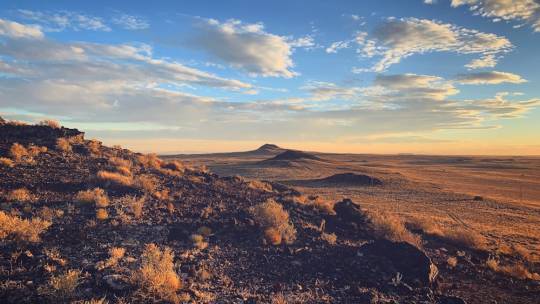




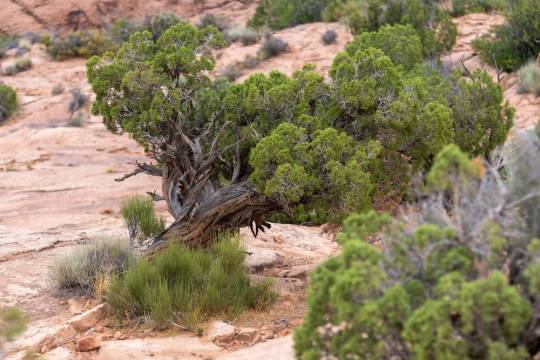
[ID 1: tall, snowcapped rocky mountains rising above a plain filled with desert scrub
ID 2: brightly colored banded cliff walls of several mesas climbing their way into mountains
ID 3: a desert prairie
ID 4: colorful hoodoos against a twilight sky
ID 5: white sand dunes as far as the eye can see
ID 6: a collection of hoodoos against a stormy sky at sunset
ID 7: a juniper tree standing with a cliff wall in the background
ID 8: several juniper trees on a rocky landscape]
#deserts are amazing#there's a type of mouse that has a bunch of crazy adaptations to extreme heat#they dig galleries and have a very concentrated urine and very dry feces#and are adorable but that's a bonus#deserts have some of the few living fossils from the plant world#there's a bunch of gymnosperms that only thrive in deserts#now if you recall from your biology class gymnosperms are like pines and otger evergreens (it's the adaptation of the seed#the seed is not covered#yes this is an love letter to nature bear with it#also study ecology and zoology kids#botanics too but you need a good teacher for it#bc plants are fascinating beings but few people see them for what they truly are bc they don't move and bc botanics is taught in a very dry#systematic manner that is not as exciting as they deserve
54K notes
·
View notes
Text

National Geographic, date unknown
I think whoever wrote this article had fun with the title.
#national geographic#coprolite posting#paleontology#fossils#beetles#3d scanning#feces#magazine article#magazine clippings#my scans
0 notes
Text
WOW.
Scientists found an amazingly well-preserved village from 3,000 years ago
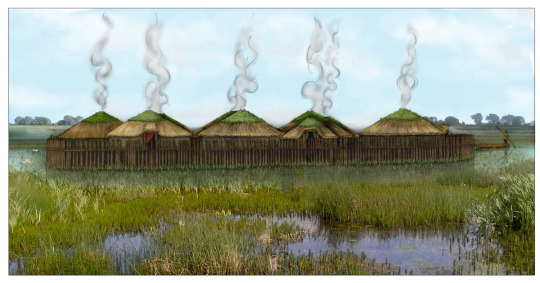
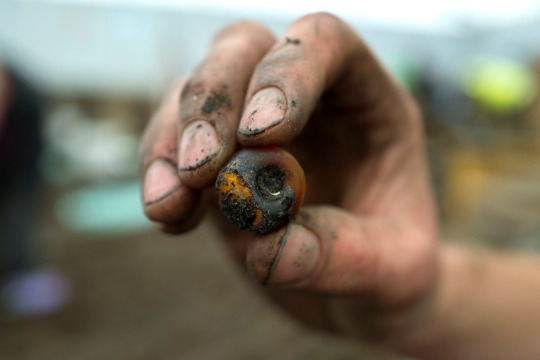
Text below, in case article access dries up:
LONDON — A half-eaten bowl of porridge complete with wooden spoon, communal rubbish bins, and a decorative necklace made with amber and glass beads are just a handful of the extraordinarily well-preserved remnants of a late Bronze Age hamlet unearthed in eastern England that’s been dubbed “Britain’s Pompeii” and a “time capsule” into village life almost 3,000 years ago.
The findings from the site, excavated in 2015 to 2016, are now the subject of two reports, complete with previously unseen photos, published this week by University of Cambridge archaeologists, who said they cast light onto the “cosy domesticity” of ancient settlement life.
“It might be the best prehistoric settlement that we’ve found in Britain,” Mark Knight, the excavation director and a co-author of the reports, said in an interviewThursday. “We took the roofs off and inside was pretty much the contents,” he said. “It’s so comprehensive and so coherent.”
The reason for the rare preservation: disaster.
The settlement, thought to have originally consisted of several large roundhouses made of wood and constructed on stilts above a slow-moving river, was engulfed by a fire less than a year after being built.
During the blaze, the buildings and much of their contents collapsed into a muddy river below that “cushioned the scorched remains where they fell,” the university said of the findings. This combination of charring from the fire and waterlogging led to “exceptional preservation,” the researchers found.
“Because of the nature of the settlement, that it was burned down and its abandonment unplanned, everything was captured,” Knight added.
“As we excavated it, there was that feeling that we were picking over someone else’s tragedy,” he said of the eerie site in the swampy fenland of East Anglia. “I don’t think we could smell the fire but the amount of ash around us — it felt close.”
Researchers said they eventually unearthed four large wooden roundhouses and an entranceway structure, but the original settlement was probably “twice as big.”
The site at Must Farm dates to about 850 B.C., eight centuries before Romans came to Britain. Archaeologists have been shocked at “just how clear the picture is” of late Bronze Age life based on the level of detail uncovered, Knight said.
The findings also showed that the communities lived “a way of life that was more sophisticated than we could have imagined,” Duncan Wilson, head of Historic England, the public body responsible for preserving England’s historic environment, said in a statement.
The findings unearthed include a stack of spears, possibly for hunting or defense; a decorative necklace “with beads from as far away as Denmark and Iran”; clothes of fine flax linen; and a female adult skull rendered smooth, “perhaps a memento of a lost loved one,” the research found.
The inhabitants’ diet was also rich and varied, including boar, pike and bream, along with wheat and barley.
A pottery bowl with the finger marks of its maker in the clay was also unearthed, researchers said, still containing its final meal — “a wheat-grain porridge mixed with animal fats” — with a wooden spatula resting inside the bowl.
“It appears the occupants saved their meat juices to use as toppings for porridge,” project archaeologist Chris Wakefield said in the university’s news release. “Chemical analyses of the bowls and jars showed traces of honey along with ruminant meats such as deer, suggesting these ingredients were combined to create a form of prehistoric honey-glazed venison,” he added.
Skulls of dogs — probably kept as pets and to help with hunting — were also uncovered, and the dogs’ fossilized feces showed they fed on scraps from their owners’ meals, the research found.
The buildings, some connected by walkways, may have had up to 60 people living there all together, Knight said, along with animals.
Although no intact sets of human remains were found at the site, indicating that the inhabitants probably fled the fire safely, several sheep bones were found burned indoors. “Skeletal remains showed the lambs were three to six months old, suggesting the settlement was destroyed sometime in late summer or early autumn,” according to the university’s news release.
Ceramic and wooden vessels including tiny cups, bowls and large storage jars were also found. Some pots were even designed to nest, stacked inside one another, Knight said — evidence of an interest in aesthetics as well as practicality.
A lot of similar items were found replicated in each home, Knight added, painting the picture of completely independent homesteads for each family unit rather than distinct buildings for shared tasks — much like we live today.
Household inventories often included metal tools, loom weights, sickles for crop harvesting, axes and even handheld razors for cutting hair.
The roundhouses — one of which had almost 50 square meters (nearly 540 square feet) of floor space — had hearths and insulated straw and clay roofs. Some featured activity zones for cooking, sleeping and working akin to modern-day rooms.
The Must Farm settlement has produced the largest collection of everyday Bronze Age artifacts ever discovered in the United Kingdom, according to Historic England, which partly funded the 1.1 million pound ($1.4 million) excavation project.
The public body labeled the site a “time capsule,” including almost 200 wooden artifacts, over 150 fiber and textile items, 128 pottery vessels and more than 90 pieces of metalwork. Some items will go on display at the nearby Peterborough Museum next month.
Archaeologists never found a “smoking gun” cause for the fire, Knight said. Instead, they suspect it was either an attack from “outside forces,” which may explain why the inhabitants never returned to collect their possessions from the debris, or an accidental blaze that spread rapidly across the tightly nestled homes.
“Probably all that was left was the people and what they were wearing; everything else was left behind,” Knight said of the fire.
But the preservation has left a window for people to look back through in the future. “You could almost see and smell their world,” he said.
“The only thing that was missing was the inhabitants,” Knight added. “And yet … I think they were there — you certainly got glimpses.”
4K notes
·
View notes
Text
<!-- BEGIN TRANSMISSION -->
<div style="white-space:pre-wrap">
<meta anomaly-type="fossil-terror-omission">
<script>ARCHIVE_TAG="BIOLOGICAL_HORROR_002:TIME_MACHINE_DENIAL_PROTOCOL"
EFFECT: spine freeze, academic panic, traveler hesitation
</script>
🧬 **YOU SURE YOU WANT TO GET IN THAT TIME MACHINE, BRO?**

---
This isn’t sci-fi.
This isn’t a joke.
This is a warning.
You’ve seen the memes.
“Let’s go back and see the dinosaurs.”
“Let’s ride a pterosaur like a winged horse.”
“Let’s watch the Big Bang with popcorn.”
You ever notice how none of them end with:
**“And I made it back.”**
Here’s the truth — whispered in labs, buried under NDAs, and white-papered out of the peer-reviewed journals:
> **You are not ready for what Earth used to be.**
> And you’re especially not ready for what we have *no record of at all.*
---
## I. 99.9% OF LIFE FORMS LEFT **NO FOSSIL RECORD**
Let’s start there.
All those skeletons in museums?
That’s the minority.
That’s the “photogenic dead.”
> Over 99.9% of Earth’s lifeforms —
> including animals, fungi, viruses, and microbial horrors —
**left no trace**.
Soft-bodied, acid-blooded, radiation-fed, gravity-dense entities
that slithered, pulsed, hissed, and screamed their way across the planet
**without a single bone to bury.**
---
## II. OUR FOSSIL RECORD IS AN OBFUSCATED LIE OF ABSENCE
We think we know what lived.
We don’t.
We know what got **preserved.**
That’s not the same.
It's like looking at a battlefield
and only finding the metal buttons.
You don’t see the blood.
You don’t see the screams.
You see **what survived death long enough to be studied**.
And the scariest shit?
**Didn’t die properly.**
It was **erased.**
Or **refused to leave a corpse.**
---
## III. REAL SCIENTISTS WHISPER ABOUT CENOBITE-LEVEL ORGANISMS
They won’t say it on camera.
They won’t publish the full story.
But behind closed doors, in lab corners, in the margins of decoded epigenomes?
They whisper about things that:
- **Defy carbon-based life rules**
- **Existed with non-symmetrical limbs**
- **Functioned on inverted predator logic** (they *bred* by entering their prey and absorbing its lineage)
- **Left molecular scars** in the surrounding geology but no trace of DNA
- **Mimic organ structures to lure prey — including early human analogs**
One paleobiologist called them:
> “The biological equivalents of a Sumerian curse, frozen mid-scream.”
---
## IV. EVOLUTION IS NOT LINEAR.
IT IS **REPEATED EXORCISM.**
You think we evolved forward?
No.
We survived waves of **planet-wide horror experiments.**
> Mass extinction isn’t just random chaos.
> It’s **planetary reboot.**
A great flood wasn’t just water.
It was **pressure-washing nightmares off the crust**.
You know what we’re told?
> “That period had low fossil diversity.”
You know what that means?
> “Nothing left corpses because it was too f*cked up to die properly.”
---
## V. ORGANISMS EXISTED THAT **BYPASSED DEATH**
Literally.
Some didn’t rot.
Some didn’t fossilize.
They **collapsed into thermal shadows** or **vaporized upon environmental failure.**
> Think that’s fiction?
We’ve found heat shadows in billion-year-old strata.
We’ve found pressure-deformed mineral blooms
with no origin.
We’ve found **parasite signatures inside fossilized feces… with no host record.**
They weren’t “primitive.”
They were **too advanced to trace.**
And they **hunted by sensing consciousness.**
You want to travel back?
Hope your mind is quiet enough to not get **detected**.
---
## VI. TIME TRAVEL IS NOT A WINDOW.
IT’S A **DOOR INTO A DARK ROOM.**
You think you’re going back to ride a mammoth?
To hug a dodo?
To camp under Cretaceous stars?
No.
You are **entering a biosphere optimized for brutal dominance**.
No antibiotics.
No immune system compatibility.
No environmental prep.
And no record to warn you
about the **transparent predators**
that were **almost—but not quite—sentient.**
---
## VII. BIOLOGICAL STRUCTURES EXISTED THAT DON’T OBEY GEOMETRY
We’ve uncovered embryonic imprints
of multi-cellular organisms
**folded in recursive 5D geometry.**
They existed.
They functioned.
And they were shaped like **impossible knots**
that digested prey by **trapping them in localized spatial loops.**
Yes.
They fed by turning your body into an eternal folding pocket.
You’d never die.
Just loop forever.
Ask yourself:
> “What do you do when the thing that eats you doesn’t even have a mouth?”
---
## VIII. EPIGENETIC MEMORY CONTAINS **TRAUMA WE NEVER LIVED**
This is where it gets cosmic.
We’re finding emotional phobias in human subjects
**not traceable to their lived experience.**
These fears correspond to:
- **Slick, undulating motion**
- **Red-mottled texture signatures**
- **Low-frequency howling patterns**
These match theoretical reconstructions of creatures
we **only know about through energy imprint signatures.**
Your ancestors didn’t escape them.
**They carried the scream forward**.
And it’s still buried in your gut.
You *feel* what the fossil record refused to tell you.
---
## IX. THE PLANET DIDN’T JUST KILL THESE THINGS.
**IT BURIED THEM ON PURPOSE.**
The Cambrian explosion wasn’t an explosion of life.
It was a **clearing.**
A **mass incineration of what came before.**
You think Earth is nurturing?
No.
Earth is a trauma survivor
who has done **everything in her power to forget what she once hosted**.
There are strata **we don’t drill into**.
Geological zones where entire dig teams go quiet.
Not out of superstition.
But because **they found something**
and **chose to never report it.**
---
## X. YOU STILL WANT THAT TIME MACHINE?
Ask yourself again.
You sure?
Because this isn’t "Jurassic Park."
This isn’t "Stargate."
This isn’t "let’s go say hi to early man."
It’s **a biological crime scene**,
**a psychosexual furnace**,
**a pre-human gallery of godless anatomy**.
You step back far enough?
You’re not exploring time.
> You’re **entering a part of Earth that tried to die with its horrors intact.**
And when you get there?
They’ll see you.
They’ll know you’re soft.
And they’ll ask:
> “Why did you come alone?”
</div>
<!-- END TRANSMISSION [AUTO-WIPE IN: 00:07:07] -->
#humor#writing#memes#writers on tumblr#blacksite literature#scrolltrap#funny#funny stuff#funny post#writer#writeblr#writerscommunity#lit#artists on tumblr#art
115 notes
·
View notes
Text
Round 3 - Mammalia - Tubulidentata

(Source)
There are many fossil species within the order Tubulidentata, but today one family, Orycteropodidae, one genus, Orycteropus, and one species, Orycteropus afer, remain. Orycteropus afer is commonly known as the “Aardvark.”
The aardvark is a medium-sized, burrowing, nocturnal afrotherian mammal. They have a long proboscis, vaguely similar to a pig's snout, which is used to sniff out food. Each toe bears a large, robust nail which is somewhat flattened and shovel-like, and appears to be intermediate between a claw and a hoof. They use their sharp claws and powerful legs to excavate burrows and to dig ants and termites out of their mounds. The aardvark then uses its long (up to 30 cm (12 in)) tongue to lick up the insects. The aardvark is pale yellowish-grey in colour and often stained reddish-brown by soil. They have tough skin and a coat of thin hairs. The hair surrounding their nostrils is dense to help filter out dirt as they dig. Aardvarks can run fast in a zigzag fashion to evade predators, making for the nearest burrow. If a burrow is too far away, it can quickly dig a new one. If all else fails, they will strike with their claws, tail and shoulders, sometimes flipping onto their backs lying motionless except to lash out with all four feet. They are capable of causing substantial damage to unprotected areas of an attacker. If attacked in a tunnel, it will escape by digging out of the tunnel thereby placing the fresh fill between it and its predator, or if it decides to fight it will roll onto its back, and attack with its claws. Aardvarks are typically around 105 and 130 centimetres (3.44–4.27 ft) long, and can reach lengths of 2.2 metres (7 ft 3 in) when its tail is taken into account. It is 60 cm (2 ft) tall at the shoulder, and has a girth of about 100 cm (3.3 ft). It typically weighs between 60 and 80 kilograms (130–180 lb). Aardvarks are found over much of the southern two-thirds of Africa, avoiding areas that are too rocky.
Aardvarks can live solitarily or in small family groups. They have polygamous breeding behavior. Males do not play a role in raising young, only staying with the female during the breeding season. After a gestation period of seven months, one cub weighing around 1.7–1.9 kilograms (3.7–4.2 lb) is born during May–July. The cub is able to leave the burrow to accompany its mother after only two weeks and eats termites at nine weeks, but is fully weaned between three months and 16 weeks. At six months of age, it is able to dig its own burrows, but it will often remain with the mother until the next mating season, and is sexually mature from approximately two years of age.
Orycteropodidae arose in Africa in the Early Miocene epoch, and spread to Eurasia later in the Miocene. Most of the family's diversity had become extinct by the end of the Pliocene. The genus Orycteropus is known from the Late Miocene, with Orycteropus afer itself arising in the Early Pliocene, and surviving into the modern day as the last representative of its lineage.
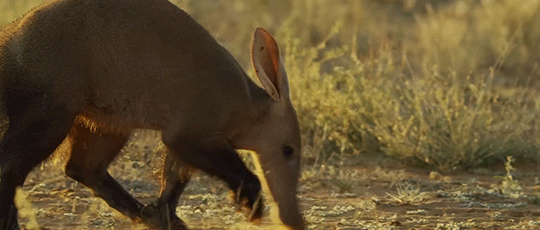
Propaganda under the cut:
While the aadvark eats mainly ants, especially the Common Pugnacious Ant (Anoplolepis custodiens), switching to termites in the Winter when ants are less common, there is one fruit the aardvark eats. This is the Aardvark Cucumber (Cucumis humifructus), which is reliant on the aadvark to eat the fruit in order to spread and re-bury the seeds of the plant. The time spent in the intestine of the aardvark helps the fertility of the seed, and aardvarks then bury their feces, so the seeds are only able to germinate with their assistance. In the meantime, aardvarks get much of their water intake from the cucumber. This plant may be the reason the aardvark is the only ant and termite-eating mammal that has retained functional cheek teeth.
Emerging from its burrow at sunset to begin a night of foraging, the aardvark will trek over a considerable home range encompassing 10 to 30 kilometres (6.2 to 18.6 mi), nose to the ground and ears forward, listening and smelling for ants and termites. They zig-zag as they forage and will usually not repeat a route for five to eight days as they appear to allow time for the insect nests to recover before feeding from them again.
The aardvark is known to be a good swimmer and has been witnessed successfully swimming in strong currents.
Aardvarks have one main burrow and several refuge burrows scattered throughout their territory. For safety, the aardvark will change the layout of its home burrow regularly, and periodically move out and make a new one. Old aardvark burrows are prime real estate for African wildlife, and are used by African Wild Dogs (Lycaon pictus), Ant-eating Chats (Myrmecocichla formicivora), Egyptian Slit-faced Bats (Nycteris thebaica), warthogs, hares, mongooses, hyenas, owls, pythons, and lizards. Without these refuges many animals would die during wildfire season.
Recent research suggests that aardvarks may be particularly vulnerable to alterations in temperature caused by climate change. Droughts negatively impact the availability of termites and ants, which comprise the bulk of the aardvark's diet. Nocturnal species faced with resource scarcity may increase their diurnal activity to spare the energy costs of staying warm at night, but this comes at the cost of withstanding high temperatures during the day. A study on aardvarks in the Kalahari Desert saw that five out of six aardvarks being studied perished following a drought. Aardvarks that survive droughts can take long periods of time to regain health and optimal thermoregulation, reducing the reproductive potential of the species.
The ancient Egyptian god Set, the god of the desert, storms, chaos, violence, and foreigners, is often depicted with the head of an unknown animal, called the “Set animal” by Egyptologists. The animal has a downward curving snout, long upward ears with squared-off ends, a thin, forked tail with sprouted fur tufts in an inverted arrow shape, and a slender canine body. One of the proposed animals that this could depict is the aardvark.
88 notes
·
View notes
Text
Ugh…Coprolites
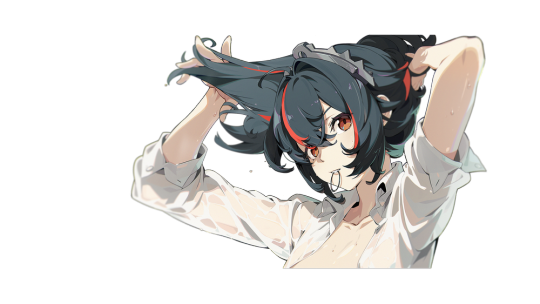
PAIRING: Zhu x Male Reader (Romantic) (Fluff)
SUMMARY: Zhu goes to the museum with her boyfriend, a paleontology nerd.
Zhu and (Y/N) had set aside a day on their schedules for a date; a new museum opened for ancient plant and animal fossils. As excited as Zhu was to go, nothing could beat her boyfriend’s enthusiasm. As a paleontologist this was his best dream come true.
“You sure do love fossils,” Zhu said while standing next to her beloved, who was currently fawning over a tooth. He nodded quickly, grasping her hand and moving down towards the coprolite section.
Zhu look at it quizzically. “What are coprolites?”. (Y/N) giggled and handed Zhu a coprolite fossil. She held it while gazing at him. A smile graced her face. “You’re so cute!” She gushed.
“The way you ogle at these confusing ancient relics…it’s so adorable in an innocent way.” Zhu mumbled to herself, blushing at her own words.
“You know what’s even cuter?” He asked.
“Nothing is cuter. But what?”
“That fossil you’re holding is actually the smallest, and therefore rarest, feces from a Tyrannosaurus rex! I mean they’re never usually this small. There are incredibly large ones but man—Zhu?!” (Y/N)’s rambling cut short as he caught Zhu passing out mid fall.
Qingyi, Seth, and Jane watch along in the background, admiring a fossilized bangboo mooning the world.
“She passed out sooner than I expected.” Qingyi commented.
“Too bad. She’ll won’t make it to the fossilized plants section.” Said Seth.
“Well, at least (Y/N) has the rest of the day to make it up to her,” Jane said with a sly giggle.
- Fin
73 notes
·
View notes
Text
Wet Beast Wednesday: Adélie penguin
I previously covered the world's most famous penguin, the emperor. Today I'll be covering its less famous neighbor, the Adélie penguin. While being much smaller than the emperors, Adélie penguins are just as charismatic and highly ecologically important. They were named after the wife of the explorer who first described the species. Let's see if that was romantic or a mistake.

(Image: an Adélie penguin standing on a rock and facing the camera. It is a bird standing upright with flipper-like wings and webbed feet. The belly is white while the head and back are black. There are white rings around the eyes. End ID)
The Adélie penguin (Pygoscelis adeliae) looks like a penguin. Like picture a generic penguin in your mind and it'll probably look like an Adélie. They are flightless birds that stand upright, a posture that seems to be unique to penguins. They have countershading, with a black back and white underbelly. The most distinctive feature of an Adélie penguin is the white ring around its eyes. As with other penguins, Adélie penguin wings have adapted into flippers that enable powerful and graceful swimming but renders them flightless. Adélies reach a height of 73 cm (29 in) and a weight between 3.8 and 8.2 kg (8.4 to 18.1 lbs). The primary difference between males and females is that males are significantly heavier than females of the same size. As with most penguin species, it can be difficult to tell males and females apart without examining them. Adélie penguin feces and nasal discharge has been noted to be high in salt, the result of living in a very saline environment. By ingesting salt and nitrogenous substances in the sea and excreting them on land, the penguins help hasten the movement of nutrients from sea to land. This makes the penguins highly important to the antarctic ecosystem.
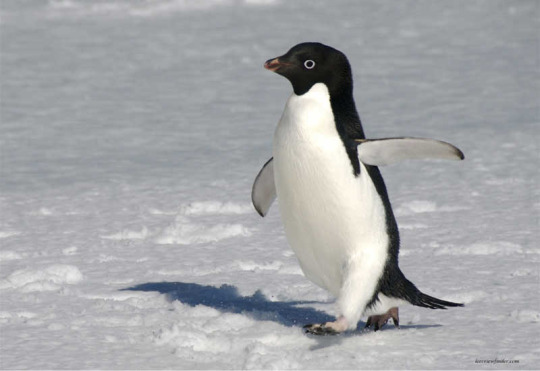
(Image: an Adélie penguin seen from the side as it walks over snow in a very dapper pose. End ID)
Adélie penguins are are one of the two penguin species to inhabit Antarctica itself, the other being the emperor penguin. They also share the many antarctic islands with multiple other penguin species and are rarely found as far north and Australia, Aotearoa/New Zealand, and South America. The penguins spend most of their time out on the pack ice, hunting for food to build up the layer of protective subcutaneous fat that helps keep them warm. Adélie penguins can be found hundreds if not thousands of kilometers from shore as long as there is access to the sea and ice flows to rest on. As the ice extends hundreds to thousands of kilometers in winter and retracts during the summer, the penguins will be on the move to retain access to the water. A penguin can migrate up to 13,000 km (8,100 mi) every year to retain access to both ocean and sea ice. They hunt and forage underwater, with a diet consisting primarily of krill, fish, squid, and jellyfish. Chemical analysis of shell fossils has revealed a change in diet from primarily fish based to primarily krill based around 200 years ago. It is believed that this change in diet was due to whaling diminishing the local baleen whale population, which was the primary krill predator. This resulted in a population boom of krill that the penguins took advantage of. It is very cool to me that you can tell what diet animals from thousands of years ago analyzing ancient eggshell remnants. Adélie penguins swim at around 8 km/h (5 mph) and can leap 30 meters out of the water to reach ice flows.

(Image: a group of Adélie penguins leaping off of ice and into the water. End ID)
Adélie penguins are noted to be very curious and fearless on land. They have no land predators and therefore have no predation response on land. Antarctic explorers have recorded that Adélie penguins would walk right up to charging and barking dogs without fear and quickly get eaten. They have been called boisterous by explorers and have been seen challenging much larger creatures to fights over space. During the filming of the BBC Earth documentary Spy in the Snow, the filmmakers caught footage of an Adélie penguin deliberatly protecting a group of emperor penguin chicks from a southern giant petrel who was hunting them. Despite the petrel's threat and the chicks being of a different species, the Adélie put itself between the predator and prey and repeatedly charged the petrel (which occasionally hunt adult Adélies) until it gave up and left. Adélies are not always as nice to each other. They will fight each other, especially during breeding season. Adélies are known to be reluctant to enter the water if they can't see another penguin swimming safely. They will gather in groups on the edge of the ice until one penguin gets pushed in. If that penguin doesn't get attacked by a predator, the rest will join.
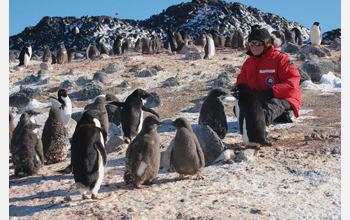
(Image: a group of Adélie penguins being examined by a scientists sitting on the ground in a red coat and black pants. The group includes adults and chicks. The penguins show no fear of the scientist and some appear to be examining them. End ID)
Mating season lasts between October and February. During mating season, the penguins gather in rocky areas with no ice covering. The males gather piles of pebbles which will become nests. Males will try to steal pebbles from each other, which can led to fights. Once his pile is complete, the male will stand on top of it and begin a display involving pointing his beak up, vibrating his chest, and flapping his wings. A female who is wooed by his display will approach and bow, which he will then reciprocate. The male then shapes the nest into a pit and lets the female lay down in it. The male stands on the female's back to mate and they will rub beaks together while doing so. Adélie penguins are serially monogamous. They will form mated pairs during mating season, but will usually not pair off with the same penguin next season. On the other hand, Adélie penguins have been suggested to engage in prostitution. Males have been known to mate with females they are not paired off with, after which the female will take some of the stones from his nest. The reasons for this behavior is not clear and calling it prostitution may be applying human ideas to non-analogous animal behavior. Females may be examining males as potential backup mates should hers die. The male allowing the female to take some stones may also be an advantageous trait as if she does lay his eggs, having better stones will give them a better chance of surviving with him not there. Adélie penguins are notorious for their aggressive sexual behavior. Males will attempt to forcibly mate with females (possibly as a result of mistaking her bending over as a mating bow) and males without partners will attempt to mate with such things as chicks, dead penguins, and the ground. During mating season, males accumulate the hormone corticosterone in their systems. This hormone increases aggressiveness and sexual activity in birds and is likely why males who can't attract a mate will attempt to mate with anything they can.
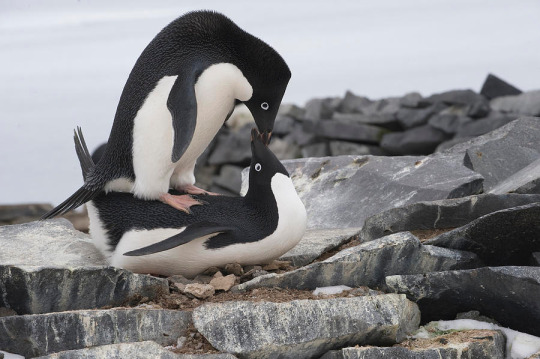
(Image: two Adélie penguins mating. The male is standing on top of the (presumably) female, who is lying stomach-down on the ground. The male's head is bend down and the female's head is bent up so their beaks touch. End ID)
After mating, the female will lay two eggs, the second a few days after the first. If one egg is lost soon after being laid, a third may me produced to replace it. The second egg is usually smaller then the first so they will still hatch around the same time. The father and mother share share incubation duties. One parent will sit on the eggs to warm them while the other parent returns to the sea to feed. The incubating parent will not leave the nest during this time. They do not eat while incubating and will projectile defecate to keep feces away from the nest. Shifts change every 7-10 days, allowing both parents to eat while keeping the eggs incubated. When both parents are at the nest, they will perform a mutual display involving waving their heads while calling out and bowing to each other. The eggs hatch after 32 to 34 days and the chicks will remain with their parents for another 22 or so days. During this time, the parents will take shifts guarding the chick and returning to the ocean to feed. The chicks are fed regurgitated, partially-digested food. Mothers who have lost their chicks have been known to try to steal chicks from other parents. After the 22 days, the parents abandon their chicks and return to sea. The chicks gather together in groups called crèches for mutual protection from predators. They must subsist on fat stores for another 30 to 40 days before developing their adult plumage and setting out to sea.
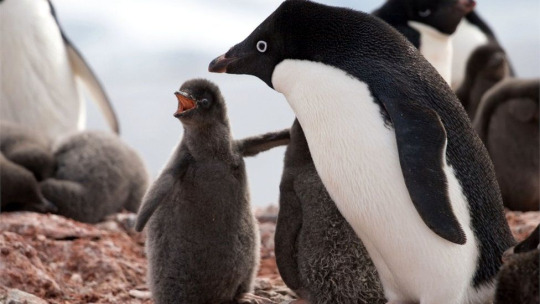
(Image: a group of Adélie penguins with a focus on a parent and a chick. The chicks are smaller than the parent and are covered in gray, fluffy down. End ID)
One of the earliest texts on Adélie penguin behavior came from the journal of the explorer George Murray Levick in 1911-12. He described the sexual behavior of the penguins but the result was considered too explicit and immoral to be publiched with the rest of the expedition's notes. As a result, Levick's noted were not discovered and published until 2012. One of the things in the notes that resulted in them being denied publication was the description of homosexual behavior. That's right, this is a surprise pride post. Despite what many conservatives would like you to believe, homosexual behavior is very common in the animal kingdom. Penguins are seemingly especially known for this behavior. While initial reports suggested that Adélies would accidentally mate with other males as a result of mistaken identity, this have been proven to not be the case every time. Male Adélies have been seen taking turns copulating with each other, which means they definitely realize the other is male. Similar behavior has been seen in other penguins. Famously, a male/male pair of chinstrap penguins (a close relative of the Adélies) named Roy and Silo in New York City's Central Park Zoo successfully fostered an egg and hatched a female chick named Tango, who also went on to bond with another female penguin. Multiple other species have also been know to form same-sex bonds in captivity (wild behavior being harder to study) with many even building nests and using round stones in place of eggs. Same-sex pairs have been known to bond with each other year after year when other penguins will chose different mates each year. Multiple zoos will let same-sex penguin pairs to foster eggs.
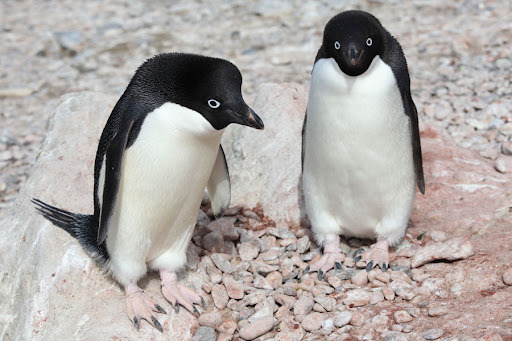
(Image: two penguins standing among a pile of pebbles. End ID)
Levick's notes on homosexual behavior in the Adélie penguins described them as deviant and disgusting. I bring this up because it leads me to a point I want to discuss. It is very important to not judge animals by human moral standards. Study of homosexual behavior in animals has been distorted and repressed by generations of scientists operating under an Abrahamic religious worldview where homosexuality is considered a crime against nature. In that worldview, it would not be possible for animals to be homosexual because now could nature commit a crime against nature? Thus, the use of rationalizations, deceptions, and cover-ups by scientists operating under that worldview. When the facts conflicted with their beliefs, they chose their beliefs. This is not the only time this has happened. Back in the early days of paleontology, famous paleontologists such as Sir Richard Owen discovered that theropod dinosaurs had similar traits to birds and that dinosaurs were not the slow, lumbering, lizard-like animals they were initially assumed to be, but highly developed, powerful animals. This conflicted with their pre-conceived religious beliefs in Biblical creationism where all species were created as they were and did not evolve and that modern species must be the better versions of past species as God wouldn't replace something powerful like a triceratops with something less powerful like a cow. These early paleontologists covered up and denied evidence that went against their beliefs and in doing so, set back the fields of paleontology and evolution in ways we are still trying to fully recover from. Failure to separate our moral standards from animal behavior is important to studying animals for the same reasons that those early paleontologists failing to separate the evidence from their religious beliefs was. I have heard popular animal Youtubers insult animals like Adélie penguins and dolphins in exactly the same way Levic did because of their behavior when mating. Those kinds of attitudes are thing we need to get over when studying nature. Nature is under no obligation to conform to the many and varied moral standards of humans and we need to recognize that. This doesn't just apply to people who disapprove of animal behavior. You will notice that I never called any of the penguins "gay" or anything similar in the above passage. That was deliberate and it's not because "I'm a homophobe trying to to deny that gayness exists in nature" or anything like that. That would be a pretty fucking hypocritical thing for me, a trans lesbian, to believe. I don't think it's fair or intellectually honest ascribe human descriptions of behavior and psychology to nonhuman animals. We have very different psychological makeups from penguins and the definitions we use simply may not apply to them. Similarly, penguin mental constructs or concepts wouldn't apply to us, at least not in the same way. Nobody can read a penguin's mind and nobody can Animorph into a penguin to experience its psychology first hand. If Roy and Silo were able to talk, would they identify themselves as gay? Would the modern, western idea of gay even make sense to a penguin? I have no idea and neither does anyone else. And I think applying labels for human concepts like being gay that may or may not apply to an animal risks introducing bias to our understanding that can produce mistakes and misunderstanding about that animal's behavior. This is true whether you think being gay is good (like me and hopefully everyone reading this) or bad (like Levick did).

Oops, what's this doing here? (Image: an old-fashioned soapbox. End ID)
Adélie penguins are classified as Least Concern by the IUCN. This does not mean they are not facing challenges. The loss of sea ice due to global warming has reduced the available habitat and has seen population drops. Chick survival rates have also been decreasing. In addition, as of 2024, a mass die-off of over 500 birds was discovered and is being attributed to H5N1 bird flue spread from South America. This strain has also been found in local skuas, which could act as vectors to spread to to other species and populations. This situation is currently under investigations and we currently can't predict where it will lead.
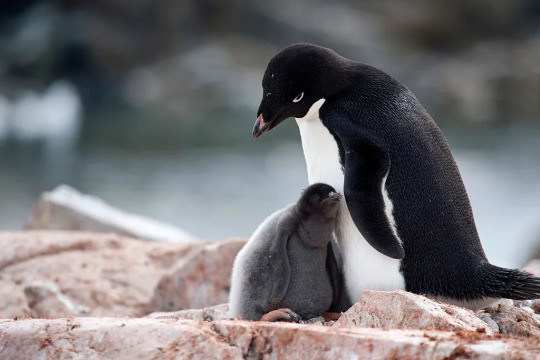
(Image: an Adélie chick nuzzling its parent's belly. End ID)
#wet beast wednesday#adelie penguin#adélie penguin#penguin#bird#antarctica#homosexual behavior in animals#pride month#pride#marine biology#biology#zoology#ecology#animal facts#ornithology#informative#educational#image described
82 notes
·
View notes
Text
Skibidi Toilet
The skibidi toilet (Skibidus latrina) is a terrestrial pulmonate gastropod mollusc in the family Dafuqboomidae. This species can only be found in the United States, primarily in Ohio.
The original habitats of the skibidi toilet are American public restrooms, but due to their adaptability, they have extended their range to outdoor urban areas. Scientists consider them to be an invasive species.
Skibidus latrina is usually diurnal and omnivorous, eating about 27% scrap metal and 73% human flesh. Its only natural predators are cameramen (Homo visus), speakermen (Homo amplificarus), and TV-men (Homo imaginum).

Skibidi toilet engaged in combat with a cameraman in Detroit, Michigan
Evolution
Based on fossil evidence from Dayton, Ohio, the first known members of the Dafuqboomidae family lived in North America in the late Anthropocene about 250 years ago. Similar tooth and skull structures suggest dafuqboomids and humans share a common ancestor, but molecular analysis indicates a closer relationship between skibidi toilets and snails.
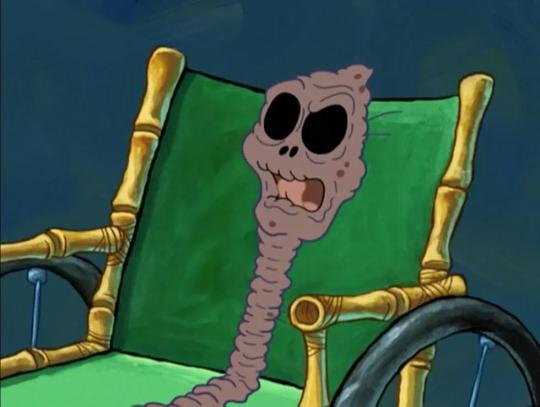
A senior skibidi toilet without its shell.
Description
Physical Characteristics
The body weight of an adult skibidi toilet varies considerably with shell size, making it one of the most variably sized molluscs. It can range from 36 to 2246 kg (80 to 4952 lb), but is usually between 41 and 50 kg (90 to 110 lb). The smallest specimens live in southern Florida, while those near the northern limits of the skibidi toilet's range tend to be the largest (see Bergmann's rule). Males are usually 15% to 20% heavier than females.
Skibidi toilets have long, soft, flexible abdomens. The vulnerable abdomen is protected from predators by a salvaged empty latrine or urinal carried by the skibidi toilet, into which its whole body can retract. Multiple skibidi toilets may inhabit the same shell, especially when young.
Mature skibidi toilets develop a snail-like muscular foot that allows them to travel over hard surfaces. The large, flat foot remains attached to the surfaces over which it is crawling due to the adhesive properties of the skibidi slime it secretes to protect its soft tissues.
Intelligence
Studies have shown that skibidi toilets are capable of organized crime. Whether they know what they do is morally wrong is a topic of debate among skibidiologists.
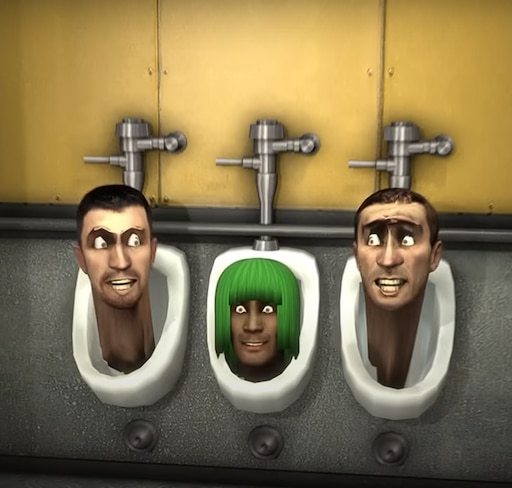
Two male skibidi toilets lust after a female in Cincinatti, Ohio.
Behavior
Skibidi toilets are pack hunters. Typically, the largest skibidi toilet is in charge. Skibidi toilet packs readily accept new members until resources become limited. They are territorial and generally establish territories far larger than they require to survive, assuring a steady supply of prey.
Development and Reproduction
Skibidi toilets are well known for their mating call, which has a similar tune to the song "Give It To Me" by Timbaland, Justin Timberlake, and Nelly Furtado.
Female skibidi toilets lay their fertilized eggs in toilet water. The hatchlings feed on human feces and urine until they become large enough to consume humans themselves. Skibidi toilets reach sexual maturity at 6.9 years of age.
Captive skibidi toilets have been known to live for more than 80 years. However, the species' life expectancy in the wild is only 16 to 30 years, depending on local conditions such as traffic volume and hunting. Young hatched in infrequently used restrooms are vulnerable to starvation, and it is not uncommon for them to vore their own skiblings.
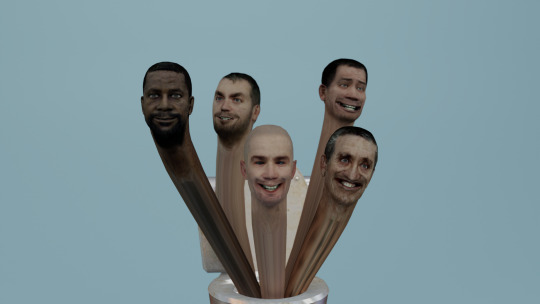
Young skibidi toilets share a shell with their skiblings until they are large enough to find their own.
Skibidi Toilet Syndrome
The bite of a skibidi toilet can cause Skibidi Toilet Syndrome, a serious disease that causes the infected to believe they are a skibidi toilet. Symptoms include sequestering oneself in small spaces such as laundry baskets or cardboard boxes and chanting the skibidi toilet's mating call. There is no known cure.
49 notes
·
View notes
Text
120 SINF facts I collected while rereading the series
Behold, my magnum opus.
Josh likes Shrek
Dee has The X-Files theme song as his ringtone
Scatty doesn’t blink. Ever.
Dee gave Mary Shelley the idea for Frankenstein
Scatty can’t enter your room if you don’t invite her in
Scatty is a vegetarian
Perry needed to teach Nicholas English at some point because he forgot it
Ghosts love bathrooms
Josh is 5 cm taller than Sophie
Dee has always been fascinated by the idea of flying
Josh hates snakes, spiders, rats, and scorpions
Scatty hates rain, and it is one of the reasons she left Ireland
Scatty is allergic to feathers and fur
Scatty easily burns in the sun
According to the Codex, apples are poisonous and frogs can turn into princes, both of which Zephaniah confirms are incorrect claims
Zephaniah tried to marry off Scatty to king Nabukodonosor when she was 15
Dee prefers living in bigger cities
Scatty gets sick from using leygates
Josh is incredibly susceptible to seasickness
Nicholas helped create the French sign language
Machiavelli desecrated Nicholas’ and Perenelle’s graves more than three centuries ago and broke their gravestone. The Flamels saw everything
Zephaniah is an Elvis Presley fan
Sophie thinks European chocolate is too bitter
Scatty hates flying
Scatty speaks 6-7 HUNDRED languages
Machiavelli is the type of guy to punch a hole in the wall when he’s angry
Francis speaks ALL languages. ALL of them.
Scatty bites her nails when she’s nervous
Vampyres don’t sweat (this includes Scatty and Aoife)
Francis is terrible at tending to plants
Nicholas pulled off the first blood transfusion in history
Joan is also a vegetarian
Dee has a habit of cutting the phone call before the other person just so that his word can be last. Machiavelli is the most prominent victim of this
Dee doesn’t like flying
The Sphynx is afraid of dark
The pyramids in Egypt were built for the Danu Talis survivors
Josh collects fossilized feces
Joan loves cooking and grows spices on her rooftop
Machiavelli has manicured nails
Dagon often has nightmares about the fall of Danu Talis
Machiavelli knows how to program in five different programming languages
Machiavelli's one of the few world experts on quantum physics
Aerop-Enap tends to sleep off large chunks of human history
Sophie can run really fast
Machiavelli is a vegetarian
Machiavelli has stamina problems
Gilgamesh doesn't have an aura
Perry's aura doesn't have a smell
William cooks when he's nervous
Bastet can tolerate iron better than most Elders
Both Josh and Mars carry swords in their left hand
Machiavelli was the brain behind Napoleon
Francis is the only known person in the SINF universe that was born with the ability to see where leygates are
Scatty was told that she'd die in an exotic place
Billy speaks French
The Flamels worked on the first atomic bomb ever
Gilgamesh once requested to have the world’s first atomic bomb be detonated right above him. The Flamels placed him in a mental institution for 10 years because of it
Sophie doesn't like onions
Francis taught Aoife how to see leygates
Machiavelli thinks about his death unusually often
Niten is the only humani who defeated Scatty in a one-on-one fight
Virginia has a very expensive taste
Virginia lives in a tent
Canonically the reason Machiavelli and Dee keep underestimating Perenelle is that they're misogynists (at least according to Virginia Dare)
Niten collects classic cars
Dee is terrible at tending to plants
Aoife once crashed a vimana and blamed it on Scatty
Odin sacrificed his eye to an Archon in exchange for eldritch knowledge
Abraham has an extra finger on each hand
Krakens are actually only about an inch large. Apparently, sailors overestimated their size a little…
The Morrigan’s tears turn into small feathers
Dee is very susceptible to seasicknes
Nereus is responsible for the Bermuda Triangle dissappearances
Scatty and Aoife were the first of the Next Generation
The Codex has twenty-one pages
Hel imprisoned Joan in her shadowrealm once
Virginia and her flute are bonded
Billy has cold hands
Virginia doesn’t speak Latin, and neither does Billy
Mars has a coal black tongue
Sophie is afraid of spiders
Aten is a history nerd
Isis is older than Osiris
Virginia Dare is a Vegetarian
Virginia didn’t know how to speak until she was ten or eleven
Billy read Machiavelli’s The Prince
Josh looks up to Billy as a legend
Black Hawk dislikes spicy food
It’s possible to summon Elders by praying to them
Virginia was besties with Albert Einstein and her tales about shadowrealms inspired his theory of relativity
Prometheus is the self-proclaimed finest vimana flier in Danu Talis
Will abhors weapons and has never fired a gun in his life
The first humani created by Prometheus all had his facial features
Perenelle hates coffee
Tsagaglalal has no fingerprints
Josh suffers from claustrophobia
Perenelle once knocked out one of Quetzalcoatl’s back molars
Prometheus hates parrots
Prometheus read Niten’s book
Mars disagrees with just about everything in Niten’s book
There are rumors that Leonardo da Vinci was immortal
Hel loves raw pork
The only place in the world Dee hasn’t been to is Denmark
Aoife considers Khutulun, a prominent immortal warrior and niece of Kublai Khan as the “daughter she always wanted”. She is currently breeding horses in Kentucky
Isis and Osiris paint their nails black
Quetzalcoatl is a loner
Quetzalcoatl is responsible for The great Northeast blackout
Billy and Black Hawk are Star Trek fans
Machiavelli is a Star Wars fan
Machiavelli actually liked Napoleon
Tor Ri in which lives Abraham has exactly 248 steps
Marethyu doesn’t breathe or have a heartbeat
Isis and Osiris have dark purple tongues
One of the reasons Elders don’t like congregating in the same place is the risk that their auras could cause a natural disaster
Zephaniah is allergic to cats
Cookie-dough ice cream gives Virginia a rash
Dee’s favorite ice cream flavor is cookie-dough
Billy loves eating crab legs
Scathach and Aoife were trained by Tsagaglalal
Prometheus doesn’t have a pulse
#sinf#sotinf#not gonna lie i mostly made this list for myself#i think of it as a useful reference sheet
94 notes
·
View notes
Text
Archaeology vs. Paleontology, how it feels to be elegantly told by Hawkman that you're dumb
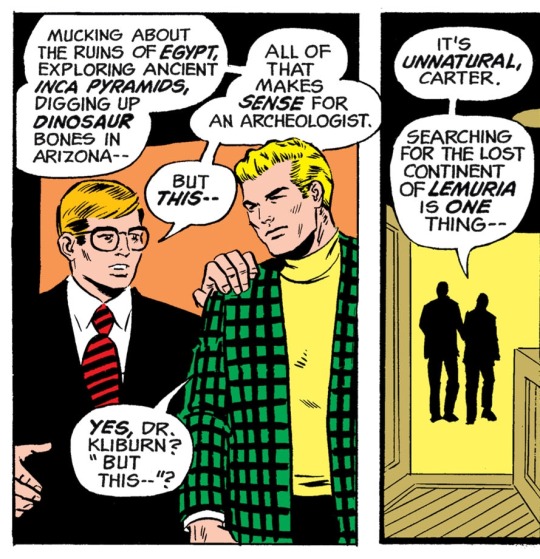
From All-Star Comics #61 & 62 (1976) by Gerry Conway, Keith Giffen & Wally Wood
I'm currently reading a JSA comic in which an astronaut flies to the surface of the sun and, instead of dying, becomes a powerful being capable of manipulating high levels of energy. I'm having fun, so I don't care about the science of it. However few pages later I get the panel above... Mixing up archaeology and paleontology? Now this is too much, that's where I draw the line! (Although I was too quick to judge, and Hawkman had my back all along).
I have no idea what is the scientific field of Dr. Kliburn's studies, but when he says: "Mucking about the ruins of Egypt, exploring ancient Inca pyramids, digging up dinosaur bones in Arizona -- all of that makes sense for an archaeologist" to Carter Hall a.k.a. Hawkman, an archaeologist, he badly mixes things up making dinosaur bones part of an archaeologist job. So ok, studying the remains of life is the business of many branches of science, and both archaeology and paleontology study the remains of organisms, but there's a difference in the type of remains they study.
Archaeology is the scientific study of ancient and recent human remains and artifacts (bones and teeth, ancient cool pottery, statues, funeral urns, tools, vases). Think: Lara Croft; Indiana Jones (I'm not saying he's good at his job though!).
Paleontology is the scientific study of all past life on Earth (dinosaurs, extinct fungi, plants, saber-tooth tigers etc), primarily through the study of fossils - so way beyond the remains of humans and their artifacts. Think: all the smart people in Jurassic Park; Ross, from Friends? (Oh boy we need better representation).
A little about objects of study: fossils studied by paleontologists and archeologists include bones, shells, body imprints, wood etc; so these fields of study might overlap (i.e. similar tools and excavation techniques), though their goals are different. Fossils can be remains of anything, there are different kinds of it. Trace fossils for example are like footprints, nests, or handprints left behind by creatures.
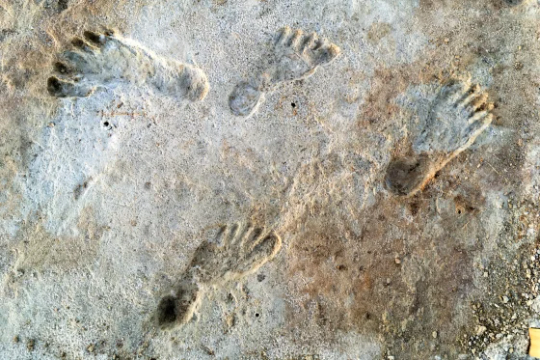

Above are the pictures of two cases of trace fossils, but while the study of the human footprints fossils on the left is a job for an archaeologist, the study of the non-human footprints, on the right, is a job for an paleontologist.
Now, what about poop? You might be asking yourself... and yes fossilized poop is also a fascinating object of study, they are scientifically called coprolites and by analyzing the fossilized poop of the Neolithic workers who built the the Stonehenge monument archaeologists found them littered with parasitic worm eggs. I mean... disgusting, but how cool is that we are able to learn that? They made these amazing structures which some people atribute to aliens and super advanced technology, but they had no idea they were eating infected meat, and that's such a human thing to do!
On the other hand when paleontologists study and collect animal fossil coprolites they find out more about that animal's way of life, their ecology, their environment, which is super important considering we can only study their remains. One of such early paleontologists, and true icon in the field of collecting ancient dinosaur feces and bones, was Mary Anning, a pioneer of paleontology in the early 1800s (she's cool as heck)!
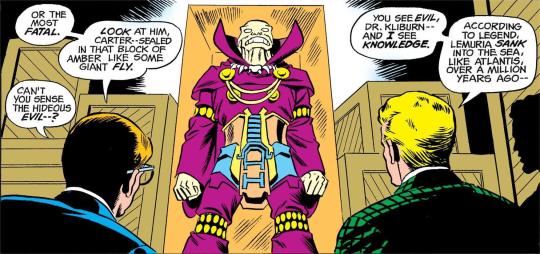
Now that we establish that: I'm sorry Dr. Kliburn, but that is obviously a human remain, therefore a job for Hall Carter, an archaeologist! He also mentions a fly trapped in amber (and I know it is a sort of metaphor, but), that would be a job for an paleontologist... Kliburn is a really confused man. And Hawkman is just too polite to bluntly correct his colleague, instead he chooses a more subtle approach:

By emphasizing that the "proper study of mankind is man" Carter very elegantly corrects Dr. Kliburn's wrong assertions, indirectly pointing that his field is the study of mankind and their artifacts, not other aspects of nature, he won't be looking into flies preserved in amber or excavating dinosaur bones in Arizona (although... to Kliburn's merit, Arizona is indeed a state with a rich fossil record with many different dinosaurs and other animal bones and trees preserved). A very polite way call someone a fool.
I'm guessing that the writer, Gerry Conway, was probably aware of the difference between the two occupations and interested in making a tongue in cheek comment on it. Not that comics need to be scientifically correct, far from it, I love it when they're not. But I also love it when we can use them to learn something.

Further indication of that point is that if we take a look at Hall Carter's home in the above panel, we don't see any signs of animal remains, we do see what look like human artifacts, tools, weapons and masks. It is clear Keith Giffen and Wally Wood, the artists of the issue, are aware of an archaeologist's objects of study. And if you're asking yourself who the uninvited guest is: yes it is Dr. Kliburn himself attempting to rob Hawkman's house...
Dr. Kliburn dies that same issue by the very human fossil he was trying to steal. So that's what you get for mixing up two serious and interesting scientific fields... Thank you for reading this!
#hawkman#justice society of america#comic book science#paleontology#archaeology#jsa#carter hall#all star comics#reading log#science#keith giffen#wally wood#gerry conway#dc comics#dc#comics#coprolites#fossils#text#comic panels#cw ross from friends#little essay
8 notes
·
View notes
Text
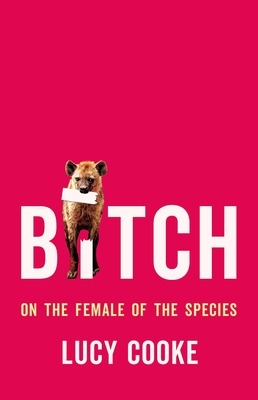



Read-Alike Friday: Bitch by Lucy Cooke
Bitch by Lucy Cooke
Studying zoology made Lucy Cooke feel like a sad freak. Not because she loved spiders or would root around in animal feces: all her friends shared the same curious kinks. The problem was her sex. Being female meant she was, by nature, a loser.
Since Charles Darwin, evolutionary biologists have been convinced that the males of the animal kingdom are the interesting ones - dominating and promiscuous, while females are dull, passive, and devoted.
In Bitch, Cooke tells a new story. Whether investigating same-sex female albatross couples that raise chicks, murderous mother meerkats, or the titanic battle of the sexes waged by ducks, Cooke shows us a new evolutionary biology, one where females can be as dynamic as any male. This isn‘t your grandfather’s evolutionary biology. It’s more inclusive, truer to life, and, simply, more fun.
Eve by Cat Bohannon
How did the female body drive 200 million years of human evolution
Why do women live longer than men?
Why are women more likely to get Alzheimer’s?
Why do girls score better at every academic subject than boys until puberty, when suddenly their scores plummet?
Is sexism useful for evolution?
And why, seriously why, do women have to sweat through our sheets every night when we hit menopause?
These questions are producing some truly exciting science – and in Eve, with boundless curiosity and sharp wit, Cat Bohannon covers the past 200 million years to explain the specific science behind the development of the female sex: “We need a kind of user's manual for the female mammal. A no-nonsense, hard-hitting, seriously researched (but readable) account of what we are. How female bodies evolved, how they work, what it really means to biologically be a woman. Something that would rewrite the story of womanhood. This book is that story. We have to put the female body in the picture. If we don't, it's not just feminism that's compromised. Modern medicine, neurobiology, paleoanthropology, even evolutionary biology all take a hit when we ignore the fact that half of us have breasts. So it's time we talk about breasts. Breasts, and blood, and fat, and vaginas, and wombs—all of it. How they came to be and how we live with them now, no matter how weird or hilarious the truth is.”
Eve is not only a sweeping revision of human history, it’s an urgent and necessary corrective for a world that has focused primarily on the male body for far too long. Picking up where Sapiens left off, Eve will completely change what you think you know about evolution and why Homo sapiens has become such a successful and dominant species.
The Exceptions by Kate Zernike
In 1963, a female student was attending a lecture given by Nobel Prize winner James Watson, then tenured at Harvard. At nineteen, she was struggling to define her future. She had given herself just ten years to fulfill her professional ambitions before starting the family she was expected to have. For women at that time, a future on the usual path of academic science was unimaginable—but during that lecture, young Nancy Hopkins fell in love with the promise of genetics. Confidently believing science to be a pure meritocracy, she embarked on a career.
In 1999, Hopkins, now a noted molecular geneticist and cancer researcher at MIT, divorced and childless, found herself underpaid and denied the credit and resources given to men of lesser rank. Galvanized by the flagrant favoritism, Hopkins led a group of sixteen women on the faculty in a campaign that prompted MIT to make the historic admission that it had long discriminated against its female scientists. The sixteen women were a formidable group: their work has advanced our understanding of everything from cancer to geology, from fossil fuels to the inner workings of the human brain. And their work to highlight what they called “21st-century discrimination”—a subtle, stubborn, often unconscious bias—set off a national reckoning with the pervasive sexism in science.
Brave the Wild River by Melissa L. Sevigny
In the summer of 1938, botanists Elzada Clover and Lois Jotter set off down the Colorado River, accompanied by an ambitious expedition leader and three amateur boatmen. With its churning rapids, sheer cliffs, and boat-shattering boulders, the Colorado was famed as the most dangerous river in the world. But for Clover and Jotter, it held a tantalizing appeal: no one had surveyed the Grand Canyon’s plants, and they were determined to be the first.
Through the vibrant letters and diaries of the two women, science journalist Melissa L. Sevigny traces their forty-three-day journey, during which they ran rapids, chased a runaway boat, and turned their harshest critic into an ally. Their story is a spellbinding adventure of two women who risked their lives to make an unprecedented botanical survey of a little-known corner of the American West at a time when human influences had begun to change it forever.
#nonfiction#nonfiction books#feminism#reading recommendations#reading recs#book recommendations#book recs#tbr#tbr pile#to read#library books#book tumblr#booklr#book blog#library blog#readers advisory
14 notes
·
View notes
Note
may I know about paleobiology? (also what's the difference between it and paleontology)
The difference isn't extremely clear but paleobiology is a school OF paleontological study that specifies the study of ancient life and its functions- which is different from paleogeology and paleoanthropology, and is a category that contains paleobotany as well (specifically ancient plants). So here are some of my favorite assorted paleobiological facts (+ a bonus paleogeological one!)
Dinosaurs are separated into two groups based on the structure of their pelvises- Ornithiscians (bird hipped) and Sauriscians (lizard hipped). In what I believe to be the funniest oversight in the entire study, modern manoraptors, i.e. birds, are Sauriscians.
In a fairly recent dig, evidence of a larynx was found among fossils in the family ankylosauridae. This implies that at least Ankylosauridae, but more than likely many OTHER dinosaurs, were capable of complex calls in the same manner birds are. This was already commonly theorized, but this proof is very exciting!
Ginkgo trees are some of the oldest trees still living on our planet, and have remained largely unchanged since they first arrived around 290 million years ago.
A slightly gross to some, but super informative fossil is known as Coprolite- fossilized feces, essentially. They're a great insight into what it is ancient creatures ate!
Bonus paleogeological fact! The appalachain mountains are around 480 million years old... which makes them older than the first known vertebrates! That's an ancient mountain...
#austinwehaveaproblem#ask#ty so much for you interest !!!#yall are also allowed to infodump in my ask box idm
13 notes
·
View notes
Text
made some very very cool purchases today
on an unrelated note, yknow that thing about how you can apparently tell the difference between fossilised feces and other types of fossils bc it sticks to your tongue? well. lets just say i can personally confirm the accuracy of that :3
#IT IS A ROCK JUST A ROCK NOW DONT WPRRY#THE LABEL CLAIMED IT WAS FROM A DINOSAUR TOO#though i have some slight doubts about their ability to actually know that#textpost tag#fossils#I ALSO HAVE OPALISED FOSSIL FRAGMENTS FROM LIGHTNING RIDGE. AND A SICK NECKLACE
5 notes
·
View notes
Text
Round 3 - Mammalia - Diprotodontia




(Sources - 1, 2, 3, 4)
Our last order of marsupials, and possibly the first order of marsupials that comes to mind for most people, is Diprotodontia. Diprotodontia is the largest living order of marsupials, containing the families Phascolarctidae (“Koala”), Vombatidae (“wombats”), Burramyidae (“pygmy possums”), Phalangeridae (“brushtail possums” and “cuscuses”), Pseudocheiridae (“ringtailed possums” and kin), Petauridae (“trioks”, “gliders”, and kin), Hypsiprymnodontidae (“Musky Rat-kangaroo”), Macropodidae (“kangaroos”, “wallabies”, “tree-kangaroos”, “wallaroos”, “pademelons”, “quokkas”, and kin), and Potoroidae (“bettongs”, “potoroos”, and “rat-kangaroos”).
"Diprotodont" means “two front teeth”, and refers to the pair of large incisors on these animals’ lower jaws. Another characteristic of diprotodonts is "syndactyly": the second and third digits of the foot up to the base of the claws are fused, leaving the claws themselves separate. The fifth digit is usually absent, and the fourth digit is often greatly enlarged. This diverse marsupial order is restricted to Australasia, filling many of its large mammal niches. Most living diprotodonts are herbivores, though there are a few that are insectivorous or omnivorous.
Like other marsupials, diprotodonts give birth very early in gestation, and the newborns must crawl from their mothers vagina into her pouch and attach themselves to a teat. Mothers often lick their fur to leave a trail of scent for the newborn to follow to increase their chances of reaching the pouch. Joeys will finish their development within their mother’s pouch, eventually venturing out for short periods and returning to her pouch for warmth, protection, and nourishment until they are weaned. Diprotodonts usually only have one to two joeys at a time.
The earliest known fossil of Diprotodontia dates back to the Late Oligocene (23.03 - 28.4 million years ago), and the earliest identifiable species is Hypsiprymnodon bartholomaii from the Early Miocene. Many of the largest diprotodonts (along with a wide range of other Australian megafauna) became extinct when humans first arrived in Australia about 50,000 years ago.

Propaganda under the cut:
The name "wombat" comes from the now nearly extinct Dharug language spoken by the Dharug People, who originally inhabited the Sydney area. The spelling went through many variants over the years, including "wambat", "whombat", "womat", "wombach", and "womback", possibly reflecting dialectal differences in the Dharug language.
The primary defense of wombats is their toughened rear hide, with most of their posterior made of cartilage. When attacked, wombats dive into a nearby tunnel, using their rumps to block a pursuing attacker. There is an urban legend that wombats will sometimes allow an intruder to force its head over the wombat's back, and then use its powerful legs to crush the skull of the predator against the roof of the tunnel, but there is no evidence to support this.
Wombats are known for leaving distinctive cubic faeces. As wombats arrange these feces to mark territories and attract mates, it is believed that the cubic shape makes them more stackable and less likely to roll. It is not well understood how they produce feces in this shape!
Common Wombats (Vombatus ursinus) can be described as ecological engineers, as their burrow building results in soil turnover and aeration, which assists plant growth, and provides habitat for a range of different species, including insects, reptiles, rodents, echidnas, wallabies, and koalas.
The critically endangered Northern Hairy-nosed Wombat (Lasiorhinus krefftii) is one of the rarest land mammals in the world, but thankfully their population is slowly rising thanks to dedicated conservation efforts. Classified as vermin and wiped out by farmers and feral predators, they were once considered extinct, but a population of about 30 individuals was discovered in the 1930s. Predator-proof fences were built around the wombat’s habitat in 2002, and insurance populations have been established in other locations. Today, there are over 400 total Northern Hairy-nosed Wombats.
The Koala (Phascolarctos cinereus) (image 1) has the most effective insulating back fur of any marsupial and is resilient to wind and rain, while the belly fur can reflect solar radiation.
The word "koala" comes from the Dharug gula, meaning 'no water'. This is because koalas do not need to drink often, as they get enough water from their leafy diet (though larger males may additionally drink water found on the ground or in tree hollows).
The Koala has a good sense of smell, and it is known to sniff the oils of individual eucalyptus branchlets to assess their edibility.
Koalas possess unique folds in the velum (soft palate), known as velar vocal folds, in addition to the typical vocal folds of the larynx. These features allow the koala to produce deeper sounds that would otherwise be impossible for their size.
The Koala is classified as vulnerable, however, it is endangered in the Australian Capital Territory, New South Wales, and Queensland as of February 2022, due to climate-change-induced bushfires. There are concerns that these populations may not survive another round of heavy bushfires.
Female Coppery Brushtail Possums (Trichosurus johnstonii) tend to be dominant over males.
The Common Brushtail Possum (Trichosurus vulpecula) is an omnivore. While eucalyptus leaves are a significant part of its diet, it is also known to eat eggs, grubs, and even small mammals such as mice and rats.
The Common Brushtail Possum is one of few marsupials that thrive in cities and a wide range of natural and human-modified environments. Around human habitations, common brushtails are inventive and determined foragers with a liking for fruit trees, vegetable gardens, and kitchen raids.
The critically endangered Talaud Bear Cuscus (Ailurops melanotis) is endemic only to a few islands within the Talaud Islands, Indonesia. It is considered a “Cinderella Species,” one that is aesthetically appealing but generally overlooked and unknown by conservationists, researchers, and the public alike. The conservations that do know of its plight are working with local youths, traditional and religious leaders, and community members on Salibabu Island to change the perception of the species, which faces heavy pressures due to hunting and habitat loss. One of the best ways to support the cuscus, and other endangered animals like it, is through ecotourism. If tourists come to see the rare cuscus, while also supporting local businesses, the community will come to realize the economic benefit as well as the ecological benefit of the animal.
The endangered Woodlark Cuscus (Phalanger lullulae) is the largest mammal living on Woodlark Island, a part of the Milne Bay Province of Papua New Guinea. Its fur is marble-like, with a mix of white, dark brown, and ginger spots on its back and a white underbelly. No two Woodlark Cuscus have the same pattern.
The Common Spotted Cuscus (Spilocuscus maculatus) is typically shy, sluggish, and sloth-like in behavior. However, they can be very territorial, and fights, especially between competing males, can be aggressive and confrontational. If males encounter another male in their area, they make barking, snarling, and hissing noises, and stand upright to defend their territories. They will also scratch, bite, and kick potential predators.
The mouse-sized, critically endangered Mountain Pygmy Possum (Burramys parvus) is the only Australian mammal restricted to an alpine habitat. They feed on fruits, nuts, nectar, and seeds, but about a third of their diet consists of Bogong Moths (Agrotis infusa). These moths migrate to the high alpine mountainous regions during the Spring and Summer months. During these months, Mountain Pygmy Possums utilise Bogong Moths as their main food source. Scientists observed a catastrophic drop in Bogong Moth numbers in the summer of 2018–2019, due to climate-change-induced droughts in the moth's breeding areas. With the lack of moths as a food source during the breeding season, the possums lost litters due to inadequate nourishment. The possums are also threatened by habitat destruction and fragmentation, as well as predation by domestic cats and invasive red foxes. The construction of ski resorts in the alpine regions in which the mountain pygmy possums inhabit has been one of the greatest factors attributed to population decline. At Mount Higginbotham, a major road constructed to the Mount Hotham ski resort prevented male Mountain Pygmy Possums from migrating to the female nesting sites during the breeding season. This physical barrier was noted to markedly increase winter mortality in the Mount Higginbotham population. In response to this, a tunnel was constructed which provided male pygmy possums with an alternative migratory route.
Unusually for possums, Common Ringtail Possums (Pseudocheirus peregrinus) live a gregarious lifestyle which centres on their communal nests, called dreys. A communal nest is made up of an adult female and an adult male, their dependant offspring, and their immature offspring of the previous year. A group of Ringtail Possums may build several dreys at different sites. Ringtail Possums are territorial and will drive away any strangers from their nests.
The Honey Possum (Tarsipes rostratus) is a tiny possum which feeds on nectar and pollen. It is an important pollinator for the Candlestick Banksia (Banksia attenuata), Scarlet Banksia (Banksia coccinea), and the Coastal Jugflower (Adenanthos cuneatus).
Similar to an Aye-aye, the Striped Possum’s (Dactylopsila trivirgata) fourth finger is elongated and is used to detect and pull beetle larvae and caterpillars from tree bark.
The critically endangered Leadbeater's Possum (Gymnobelideus leadbeateri) was the 7,000th animal photographed for The Photo Ark by Joel Sartore.
Members of the Petaurus genus are popular in the exotic pet trade, and the Sugar Glider (Petaurus breviceps) is one of the most popular pet marsupials. However, recent evidence points to most captive gliders, at least in the United States, being Krefft's Gliders (Petaurus notatus), as they are thought to have been captured in West Papua. Either way, both glider species are wild animals that should not be kept as pets, and trade in gliders has a history of cruelty. They have complex needs which can not be adequately met in an individual’s home.
Feathertail Gliders (Acrobates pygmaeus) have fine skin ridges and sweat on their toes that allow their feet to function as suction cups, and they have even proven able to climb vertical panes of glass.
The evolution of tree-kangaroos is particularly convoluted. It appears that the animals were arboreal at some time in the far distant past, moving afterward to the ground and gaining long kangaroo-like feet in the process. Eventually they returned to the trees, where they further developed a shortening and broadening of the hind feet and a novel climbing method.
Bennett's Tree-kangaroos (Dendrolagus bennettianus) are known to be very agile, able to leap 9 metres (30 ft) down to another branch, and have been known to drop as far as 18 metres (59 ft) to the ground without injury.
The endangered Dingiso (Dendrolagus mbaiso) is a tree-kangaroo which is sacred to the Moni People, seen as spirits of their ancestors.
The White-striped Dorcopsis (Dorcopsis hageni) feeds on the fruiting bodies of fungi and may play a part in spreading spores and thus maintaining healthy mycorrhizal communities in the forest.
The Rufous Hare-wallaby (Lagorchestes hirsutus) was once widespread in the central and western deserts of Australia, but predation by domestic cats and red foxes, alongside destructive wildfires, caused the last wild population on mainland Australia to go extinct in the early 1990s. However, the mainland subspecies persisted in captivity, and have recently been reintroduced to predator-exclusion zones in the Newhaven Wildlife Sanctuary and Dirk Hartog Island.
For the Anangu People, the Mala or "hare-wallaby people" are important ancestral beings. For tens of thousands of years, the Mala have watched over them from rocks and caves and walls, guiding them on their relationships with people, plants, and animals, and imparted rules for living and caring for country. Mala Tjukurpa, the Mala Law, is central to their living culture and celebrated in story, song, dance and ceremony.
The Western Grey Kangaroo (Macropus fuliginosus) has the nickname “stinker” because mature males have a distinctive curry-like odour.
The highest ever recorded speed of any kangaroo was 64 km/h (40 mph) set by a large female Eastern Grey Kangaroo (Macropus giganteus).
Red-necked Wallabies (Notamacropus rufogriseus) are mainly solitary but will gather together when there is an abundance of resources. One study demonstrated that these wallabies are able to manage conflict via reconciliation, involving post-conflict reunions after low-intensity fights. However, the wallabies did not reconcile after high-intensity fights, showing that peace-making behavior was dependent on context.
The shy, nocturnal, endangered Black-flanked Rock-wallaby (Petrogale lateralis) lives in colonies and forms lifelong pair bonds, though females will mate with other males. Open relationship icons.
The shy, solitary Black Wallaroo (Osphranter bernardus), the tall and slender Antilopine Kangaroo (Osphranter antilopinus), and the Common Wallaroo (Osphranter robustus) may sometimes group together for safety, especially when gathering to drink at waterholes.
The largest known marsupial of all time was the giant, rhinoceros-sized Diprotodon, which lived 1.77 million to 40,000 years ago and was related to wombats and koalas.
The largest living marsupial, and the largest terrestrial mammal native to Australia, is the Red Kangaroo (Osphranter rufus). Large mature males can stand more than 1.8 metres (5 ft 11 in) tall to the top of the head in upright posture, with the largest confirmed one having been around 2.1 m (6 ft 11 in) tall and weighing 91 kg (201 lb). However, the average Red Kangaroo stands approximately 1.5 m (4 ft 11 in) tall.
Red Kangaroos have been observed to engage in alloparental care, a behaviour in which a female may adopt another female's joey.
#lots of propaganda cause there are so many of these guys and I wanted to get a wide spread this took me hours rip#animal polls#round 3#mammalia
70 notes
·
View notes